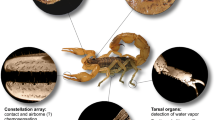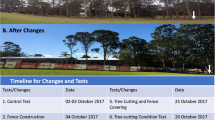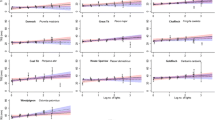Abstract
Orientation based on visual cues can be extremely difficult in crowded bird colonies due to the presence of many individuals. We studied king penguins (Aptenodytes patagonicus) that live in dense colonies and are constantly faced with such problems. Our aims were to describe adult penguin homing paths on land and to test whether visual cues are important for their orientation in the colony. We also tested the hypothesis that older penguins should be better able to cope with limited visual cues due to their greater experience. We collected and examined GPS paths of homing penguins. In addition, we analyzed 8 months of penguin arrivals to and departures from the colony using data from an automatic identification system. We found that birds rearing chicks did not minimize their traveling time on land and did not proceed to their young (located in crèches) along straight paths. Moreover, breeding birds' arrivals and departures were affected by the time of day and luminosity levels. Our data suggest that king penguins prefer to move in and out of the colony when visual cues are available. Still, they are capable of navigating even in complete darkness, and this ability seems to develop over the years, with older breeding birds more likely to move through the colony at nighttime luminosity levels. This study is the first step in unveiling the mysteries of king penguin orientation on land.





Similar content being viewed by others
References
Alves C, Boal JG, Dickel L (2008) Short-distance navigation in cephalopods: a review and synthesis. Cogn Process 9:239–247
Aubin T, Jouventin P (1998) Cocktail-party effect in king penguin colonies. Proc R Soc Lond Ser B-Biol Sci 265:1665–1673
Aubin T, Jouventin P, Hildebrand C (2000) Penguins use the two-voice system to recognize each other. Proc R Soc Lond Ser B-Biol Sci 267:1081–1087
Aubin T, Mathevon N, Staszewski V, Boulinier T (2007) Acoustic communication in the kittiwake Rissa tridactyla: potential cues for sexual and individual signatures in long calls. Polar Biol 30:1027–1033
Balcombe JP (1990) Vocal recognition of pups by mother Mexican free-tailed bats, Tadarida brasiliensis mexicana. Anim Behav 39:960–966
Balcombe JP, McCracken GF (1992) Vocal recognition in Mexican free-tailed bats—do pups recognize mothers? Anim Behav 43:79–87
Barrat A (1976) Quelques aspects de la biologie et de l'ecologie du manchot royal (Aptenodytes patagonicus) des Iles Crozet. Com Nat Fr Rech Ant 40:9–52
Bates D, Sarkar D (2006) lme4: Linear mixed-effects models using S4 classes (R package version 0.9975-10). Available at http://cran.r-project.org/src/contrib/Descriptions/lme4.html. Accessed January 25, 2007
Batschelet E (1981) Circular statistics in biology. Academic, London
Benhamou S, Poucet B (1998) Landmark use by navigating rats (Rattus norvegicus): contrasting geometric and featural information. J Comp Psychol 112:317–322
Bonadonna F, Spaggiari J, Weimerskirch H (2001) Could osmotaxis explain the ability of blue petrels to return to their burrows at night? J Exp Biol 204:1485–1489
Bonadonna F, Cunningham GB, Jouventin P, Hesters F, Nevitt GA (2003) Evidence for nest odour recognition in two species of diving petrel. J Exp Biol 206:3719–3722
Bost CA, Charrassin JB, Clerquin Y, Ropert-Coudert Y, Le Maho Y (2004) Exploitation of distant marginal ice zones by king penguins during winter. Mar Ecol Prog Ser 283:293–297
Bried J, Jouventin P (2001) The king penguin (Aptenodytes patagonicus), a non-nesting bird which selects its breeding habitat. Ibis 143:670–673
Brodbeck DR (1994) Memory for spatial and local cues—a comparison of a storing and a nonstoring species. Anim Learn Behav 22:119–133
Caduff D, Timpf S (2008) On the assessment of landmark salience for human navigation. Cogn Process 9:249–267
Challet E, Bost CA, Handrich Y, Gendner JP, Lemaho Y (1994) Behavioral time budget of breeding king penguins (Aptenodytes patagonica). J Zool 233:669–681
Cheng K (2000) How honeybees find a place: lessons from a simple mind. Anim Learn Behav 28:1–15
Cheng K, Spetch ML (1998) Mechanisms of landmark use in mammals and birds. In: Healy S (ed) Spatial representation in animals. Oxford University Press, Oxford, pp 1–17
Cheng K, Spetch ML, Kelly DM, Bingman VP (2006) Small-scale spatial cognition in pigeons. Behav Processes 72:115–127
Cheng K, Narendra A, Sommera S, Wehner R (2009) Traveling in clutter: navigation in the Central Australian desert ant Melophorus bagoti. Behav Processes 80:261–268
Cherel Y, Charrassin JB, Challet E (1994) Energy and protein requirements for molt in the king penguin Aptenodytes patagonicus. Am J Physiol 266:R1182–R1188
Chiaradia A, McBride J, Murray T, Dann P (2007) Effect of fog on the arrival time of little penguins Eudyptula minor: a clue for visual orientation? J Ornithol 148:229–233
Clark JA, Boersma PD, Olmsted DM (2006) Name that tune: call discrimination and individual recognition in Magellanic penguins. Anim Behav 72:1141–1148
Cote SD (2000) Aggressiveness in king penguins in relation to reproductive status and territory location. Anim Behav 59:813–821
Cote SD, Dewasmes G (1999) Do sleeping king penguins influence the movement of conspecifics through a colony? Polar Biol 22:13–16
Daniel TA, Chiaradia A, Logan M, Quinn GP, Reina RD (2007) Synchronized group association in little penguins, Eudyptula minor. Anim Behav 74:1241–1248
Descamps S, Gauthier-Clerc M, Gendner J-P, Le Maho Y (2002) The annual breeding cycle of unbanded king penguins Aptenodytes patagonicus on Possession Island (Crozet). Av Sci 2:87–98
Descamps S, Le Bohec C, Le Maho Y, Gendner JP, Gauthier-Clerc M (2009) Relating demographic performance to breeding-site location in the king penguin. Condor 111:81–87
Dobson FS, Jouventin P (2003a) How mothers find their pups in a colony of Antarctic fur seals. Behav Processes 61:77–85
Dobson FS, Jouventin P (2003b) Use of the nest site as a rendezvous in penguins. Waterbirds 26:409–415
Fukushi T (2001) Homing in wood ants, Formica japonica: use of the skyline panorama. J Exp Biol 204:2063–2072
Gauthier-Clerc M, Le Maho Y, Gendner JP, Durant J, Handrich Y (2001) State-dependent decisions in long-term fasting king penguins, Aptenodytes patagonicus, during courtship and incubation. Anim Behav 62:661–669
Gauthier-Clerc M, Le Maho Y, Gendner JP, Handrich Y (2002) Moulting fast and time constraint for reproduction in the king penguin. Polar Biol 25:288–295
Gauthier-Clerc M, Gendner JP, Ribic CA, Fraser WR, Woehler EJ, Descamps S, Gilly C, Le Bohec C, Le Maho Y (2004) Long-term effects of flipper bands on penguins. Proc R Soc Lond Ser B-Biol Sci 271:S423–S426
Gendner JP, Gauthier-Clerc M, Le Bohec C, Descamps S, Le Maho Y (2005) A new application for transponders in studying penguins. J Field Ornithol 76:138–142
Gibson BM, Kamil AC (2001) Search for a hidden goal by Clark's nutcrackers (Nucifraga columbiana) is more accurate inside than outside a landmark array. Anim Learn Behav 29:234–249
Gould-Beierle KL, Kamil AC (1996) The use of local and global cues by Clark's nutcrackers, Nucifraga columbiana. Anim Behav 52:519–528
Gould-Beierle KL, Kamil AC (1999) The effect of proximity on landmark use in Clark's nutcrackers. Anim Behav 58:477–488
Guinet C (1992) Predation behavior of killer whales (Orcinus orca) around Crozet Islands. Can J Zool-Rev Can Zool 70:1656–1667
Healy S (1998) Spatial representation in animals. Oxford University Press, Oxford
Insley SJ (2000) Long-term vocal recognition in the northern fur seal. Nature 406:404–405
Jansen JK, Boveng PL, Bengtson JL (1998) Foraging modes of chinstrap penguins: contrasts between day and night. Mar Ecol Prog Ser 165:161–172
Kooyman GL, Cherel Y, Lemaho Y, Croxall JP, Thorson PH, Ridoux V (1992) Diving behavior and energetics during foraging cycles in king penguins. Ecol Monogr 62:143–163
Le Bohec C (2007) Life history strategies in long-lived birds: the king penguin. Ph.D. thesis, Louis Pasteur University, p 290
Le Bohec C, Gauthier-Clerc M, Gremillet D, Pradel R, Bechet A, Gendner JP, Le Maho Y (2007) Population dynamics in a long-lived seabird: I. Impact of breeding activity on survival and breeding probability in unbanded king penguins. J Anim Ecol 76:1149–1160
Lengagne T, Jouventin P, Aubin T (1999) Finding one's mate in a king penguin colony: efficiency of acoustic communication. Behaviour 136:833–846
Leonard B, McNaughton BL (1990) Spatial representation in the rat: conceptual, behavioral, and neurophysiological perspectives. In: Kesner RP, Olton DS (eds) Neurobiology of comparative cognition. Lawrence Erlbaum, Hillsdale, pp 363–422
Loughry WJ, McCracken GF (1991) Factors influencing female-pup scent recognition in Mexican free-tailed bats. J Mammal 72:624–626
Manser MB, Bell MB (2004) Spatial representation of shelter locations in meerkats, Suricata suricatta. Anim Behav 68:151–157
Mardon J, Bonadonna F (2009) Atypical homing or self-odour avoidance? Blue petrels (Halobaena caerulea) are attracted to their mate's odour but avoid their own. Behav Ecol Sociobiol 63:537–542
Martin GR (1999) Eye structure and foraging in king penguins Aptenodytes patagonicus. Ibis 141:444–450
Martin GR, Young SR (1984) The eye of the humboldt penguin, Spheniscus humboldti—visual fields and schematic optics. Proc R Soc Lond Ser B-Biol Sci 223:197–222
Nesterova AP (2007) Age-dependent use of local and global landmarks during escape: experiments using Columbian ground squirrels. Behav Processes 75:276–282
Nesterova AP, Mardon J, Bonadonna F (2009) Orientation in a crowded environment: can King Penguin (Aptenodytes patagonicus) chicks find their creches after a displacement? J Exp Biol 212:210–216
Nocera JJ, Forbes GJ, Giraldeau LA (2006) Inadvertent social information in breeding site selection of natal dispersing birds. Proc R Soc B-Biol Sci 273:349–355
Phillips AV, Stirling I (2000) Vocal individuality in mother and pup South American fur seals, Arctocephalus australis. Mar Mamm Sci 16:592–616
Reilly PN, Cullen JM (1981) The little penguin Eudyptula minor in Victoria. II. Breeding. Emu 81:1–19
Renouf D (1985) A demonstration of the ability of the harbor seal Phoca vitulina (L) to discriminate among pup vocalizations. J Exp Mar Biol Ecol 87:41–46
Schimek MG (ed) (2000) Smoothing and regression. Approaches, computation, and application. Wiley, New York
Searby A, Jouventin P (2005) The double vocal signature of crested penguins: is the identity coding system of rockhopper penguins Eudyptes chrysocome due to phylogeny or ecology? J Avian Biol 36:449–460
Searby A, Jouventin P, Aubin T (2004) Acoustic recognition in macaroni penguins: an original signature system. Anim Behav 67:615–625
Shettleworth SJ (1998) Cognition, evolution, and behavior. Oxford University Press, New York
Siegel S, Castellan NJJ (1988) Nonparametric statistics for the behavioral sciences, 2nd edn. McGraw-Hill, New York
Stonehouse B (1960) The king penguin Aptenodytes patagonica of South Georgia. I. Breeding behaviour and development. Falkland Islands Depend Surv 23:1–81
Suzuki S, Augerinos G, Black AH (1980) Stimulus control of spatial behavior on the 8-arm maze in rats. Learn Motiv 11:1–18
Takahashi A, Sato K, Nishikawa J, Watanuki Y, Naito Y (2004) Synchronous diving behavior of Adelie penguins. J Ethol 22:5–11
Tremblay Y, Cherel Y (1999) Synchronous underwater foraging behavior in penguins. Condor 101:179–185
Trillmich F (1981) Mutual mother–pup recognition in Galapagos fur seals and sea lions—cues used and functional significance. Behaviour 78:21–42
Viera VM, Le Bohec C, Cote SD, Groscolas R (2006) Massive breeding failures following a tsunami in a colonial seabird. Polar Biol 29:713–716
Vlasak AN (2006) The relative importance of global and local landmarks in navigation by Columbian ground squirrels (Spermophilus columbianus). J Comp Psychol 120:131–138
Wehner R (2003) Desert ant navigation: how miniature brains solve complex tasks. J Comp Physiol A -Neuroethol Sens Neural Behav Physiol 189:579–588
Wehner R, Michel B, Antonsen P (1996) Visual navigation in insects: coupling of egocentric and geocentric information. J Exp Biol 199:129–140
Weimerskirch H, Stahl JC, Jouventin P (1992) The breeding biology and population dynamics of king penguins Aptenodytes patagonica on the Crozet Islands. Ibis 134:107–117
Welch BL (1947) The generalization of “Student's” problem when several different population variances are involved. Biometrika 34:28–35
Williams TD, Rothery P (1990) Factors affecting variation in foraging and activity patterns of gentoo penguins (Pygoscelis papua) during the breeding season at Bird Island, South Georgia. J Appl Ecol 27:1042–1054
Wilson RP, Kierspel MAM, Scolaro JA, Laurenti S, Upton J, Gallelli H, Frere E, Gandini P (1999) To think of swim: does it really cost penguins more to waddle? J Avian Biol 30:221–224
Yoda K, Sato K, Niizuma Y, Kurita M, Bost CA, Le Maho Y, Naito Y (1999) Precise monitoring of porpoising behaviour of Adelie penguins determined using acceleration data loggers. J Exp Biol 202:3121–3126
Zeil J, Kelber A, Voss R (1996) Structure and function of learning flights in bees and wasps. J Exp Biol 199:245–252
Acknowledgements
We are extremely grateful to G. R. Martin for the stimulating discussion regarding penguin vision and calculations of the estimate of king penguin visual threshold. We want to thank our field assistants for their help in the field. We are indebted to F.S. Dobson and J.D. Whittington for their valuable comments on the earlier versions of the manuscript. Many thanks are due to the Institute Polaire Français—Paul-Emile Victor (IPEV) and Terres Australes et Antarctiques Françaises for the logistical support provided on the field. Also, we are indebted to Météo France for sharing their meteorological data with us. The research was funded by a grant from the French Ministry for Foreign and European Affairs—Lavoisier to C. Le Bohec, I.P.E.V. grants to F. Bonadonna (ETHOTAAF 354) and to Y. Le Maho (ECOPHY 137) and National Science Foundation International Research Fellowship (#0700939) to A. P. Nesterova. This study was performed according to IPEV and Centre National de la Recherche Scientifique guidelines for the Ethical Treatment of Animals and complied with current French regulations.
Author information
Authors and Affiliations
Corresponding author
Additional information
Communicated by C. Brown
Rights and permissions
About this article
Cite this article
Nesterova, A.P., Le Bohec, C., Beaune, D. et al. Do penguins dare to walk at night? Visual cues influence king penguin colony arrivals and departures. Behav Ecol Sociobiol 64, 1145–1156 (2010). https://doi.org/10.1007/s00265-010-0930-3
Received:
Revised:
Accepted:
Published:
Issue Date:
DOI: https://doi.org/10.1007/s00265-010-0930-3




